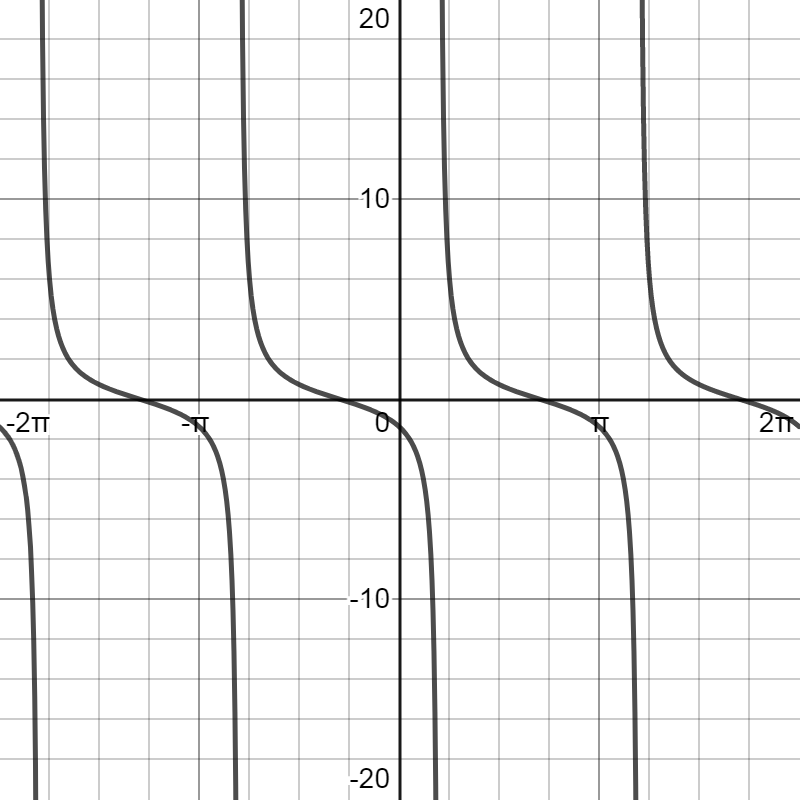
How do you graph $y = \cot \left( {x - \dfrac{\pi }{5}} \right)$?
Answer
528.9k+ views
Hint: Here, we are given the cotangent function. We know that cotangent is the periodic function. We will first use the general form equation of the cotangent function to find certain values such as the period, phase shift and vertical shift of the function.
Formula used:
$y = A\cot \left( {Bx - C} \right) + D$,where, $A$ is the vertical stretch factor, $B$ is used to find the period $P = \dfrac{\pi }{{\left| B \right|}}$, $ - \dfrac{C}{B}$ is the phase shift and $D$ is the vertical shift.
Complete step by step solution:
We will first use the general equation of the cotangent function and compare it with the given one to find the period, phase shift and vertical shift of the function.
The general form of cotangent equation is: $y = A\cot \left( {Bx - C} \right) + D$.
If we compare it with the given function $y = \cot \left( {x - \dfrac{\pi }{5}} \right)$ , we get $A = 1$ and $B = 1$, $C = - \dfrac{\pi }{5}$ and $D = 0$.
We know that cotangent function has no amplitude.
Thus, we can say that
The period of the function $y = \cot \left( {x - \dfrac{\pi }{5}} \right)$ is $P = \dfrac{\pi }{{\left| B \right|}} = \dfrac{\pi }{1} = \pi $ .
Phase shift of the function $y = \cot \left( {x - \dfrac{\pi }{5}} \right)$ is $ - \dfrac{C}{B} = - \dfrac{{\left( { - \dfrac{\pi }{5}} \right)}}{1} = \dfrac{\pi }{5}$. This value is positive and thus the shift is to the right side.
Vertical shift of the function $y = \cot \left( {x - \dfrac{\pi }{5}} \right)$ is $D = 0$.
By using this information, the graph of the given function $y = \cot \left( {x - \dfrac{\pi }{5}} \right)$ can be obtained as:

Note: The important thing to note here is that the shape of the given function $y = \cot \left( {x - \dfrac{\pi }{5}} \right)$ is same as that of the simple cotangent function $y = \cot x$. However, here $\dfrac{\pi }{5}$ is added to the angle $x$. This will result in the phase shift of the graph to $\dfrac{\pi }{5}$ units to the right. We have also seen here that the given cotangent function is a periodic function that repeats its values in regular intervals or periods.
Formula used:
$y = A\cot \left( {Bx - C} \right) + D$,where, $A$ is the vertical stretch factor, $B$ is used to find the period $P = \dfrac{\pi }{{\left| B \right|}}$, $ - \dfrac{C}{B}$ is the phase shift and $D$ is the vertical shift.
Complete step by step solution:
We will first use the general equation of the cotangent function and compare it with the given one to find the period, phase shift and vertical shift of the function.
The general form of cotangent equation is: $y = A\cot \left( {Bx - C} \right) + D$.
If we compare it with the given function $y = \cot \left( {x - \dfrac{\pi }{5}} \right)$ , we get $A = 1$ and $B = 1$, $C = - \dfrac{\pi }{5}$ and $D = 0$.
We know that cotangent function has no amplitude.
Thus, we can say that
The period of the function $y = \cot \left( {x - \dfrac{\pi }{5}} \right)$ is $P = \dfrac{\pi }{{\left| B \right|}} = \dfrac{\pi }{1} = \pi $ .
Phase shift of the function $y = \cot \left( {x - \dfrac{\pi }{5}} \right)$ is $ - \dfrac{C}{B} = - \dfrac{{\left( { - \dfrac{\pi }{5}} \right)}}{1} = \dfrac{\pi }{5}$. This value is positive and thus the shift is to the right side.
Vertical shift of the function $y = \cot \left( {x - \dfrac{\pi }{5}} \right)$ is $D = 0$.
By using this information, the graph of the given function $y = \cot \left( {x - \dfrac{\pi }{5}} \right)$ can be obtained as:

Note: The important thing to note here is that the shape of the given function $y = \cot \left( {x - \dfrac{\pi }{5}} \right)$ is same as that of the simple cotangent function $y = \cot x$. However, here $\dfrac{\pi }{5}$ is added to the angle $x$. This will result in the phase shift of the graph to $\dfrac{\pi }{5}$ units to the right. We have also seen here that the given cotangent function is a periodic function that repeats its values in regular intervals or periods.
Recently Updated Pages
Why is there a time difference of about 5 hours between class 10 social science CBSE

In cricket, what is a "pink ball" primarily used for?

In cricket, what is the "new ball" phase?

In cricket, what is a "death over"?

What is the "Powerplay" in T20 cricket?

In cricket, what is a "super over"?

Trending doubts
What is meant by exothermic and endothermic reactions class 11 chemistry CBSE

Which animal has three hearts class 11 biology CBSE

10 examples of friction in our daily life

One Metric ton is equal to kg A 10000 B 1000 C 100 class 11 physics CBSE

1 Quintal is equal to a 110 kg b 10 kg c 100kg d 1000 class 11 physics CBSE

Difference Between Prokaryotic Cells and Eukaryotic Cells




